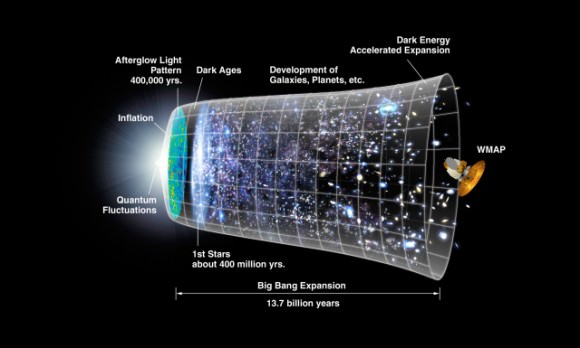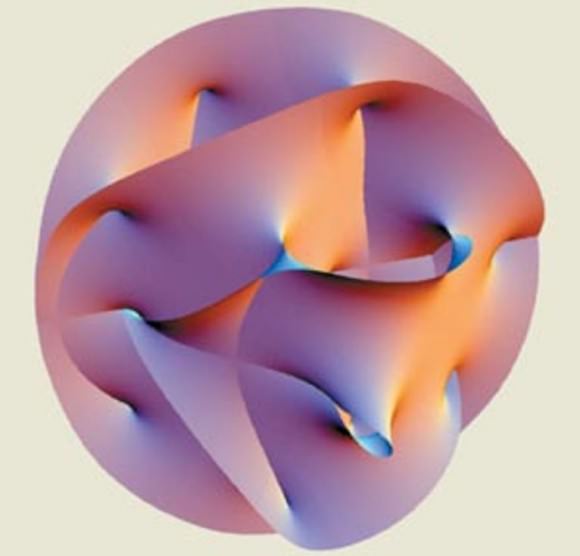When someone mentions “different dimensions,” we tend to think of things like parallel universes – alternate realities that exist parallel to our own but where things work differently. However, the reality of dimensions and how they play a role in the ordering of our Universe is really quite different from this popular characterization.
To break it down, dimensions are simply the different facets of what we perceive to be reality. We are immediately aware of the three dimensions that surround us – those that define the length, width, and depth of all objects in our universes (the x, y, and z axes, respectively).
Beyond these three visible dimensions, scientists believe that there may be many more. In fact, the theoretical framework of Superstring Theory posits that the Universe exists in ten different dimensions. These different aspects govern the Universe, the fundamental forces of nature, and all the elementary particles contained within.
The first dimension, as already noted, is that which gives it length (aka. the x-axis). A good description of a one-dimensional object is a straight line, which exists only in terms of length and has no other discernible qualities. Add to that a second dimension, the y-axis (or height), and you get an object that becomes a 2-dimensional shape (like a square).
The third dimension involves depth (the z-axis) and gives all objects a sense of area and a cross-section. The perfect example of this is a cube, which exists in three dimensions and has a length, width, depth, and hence volume. Beyond these three dimensions reside the seven that are not immediately apparent to us but can still be perceived as having a direct effect on the Universe and reality as we know it.

Scientists believe that the fourth dimension is time, which governs the properties of all known matter at any given point. Along with the three other dimensions, knowing an object’s position in time is essential to plotting its position in the Universe. The other dimensions are where the deeper possibilities come into play, and explaining their interaction with the others is where things get particularly tricky for physicists.
According to Superstring Theory, the fifth and sixth dimensions are where the notion of possible worlds arises. If we could see on through to the fifth dimension, we would see a world slightly different from our own, giving us a means of measuring the similarity and differences between our world and other possible ones.
In the sixth, we would see a plane of possible worlds, where we could compare and position all the possible universes that start with the same initial conditions as this one (i.e., the Big Bang). In theory, if you could master the fifth and sixth dimensions, you could travel back in time or go to different futures.
In the seventh dimension, you have access to the possible worlds that start with different initial conditions. Whereas in the fifth and sixth, the initial conditions were the same, and subsequent actions were different, everything is different from the very beginning of time. The eighth dimension again gives us a plane of such possible universe histories. Each begins with different initial conditions and branches out infinitely (hence why they are called infinities).
In the ninth dimension, we can compare all the possible universe histories, starting with all the different possible laws of physics and initial conditions. In the tenth and final dimension, we arrive at the point where everything possible and imaginable is covered. Beyond this, nothing can be imagined by us lowly mortals, which makes it the natural limitation of what we can conceive in terms of dimensions.

The existence of these additional six dimensions, which we cannot perceive, is necessary for String Theory for there to be consistency in nature. The fact that we can perceive only four dimensions of space can be explained by one of two mechanisms: either the extra dimensions are compactified on a very small scale, or else our world may live on a 3-dimensional submanifold corresponding to a brane, on which all known particles besides gravity would be restricted (aka. brane theory).
If the extra dimensions are compactified, then the extra six dimensions must be in the form of a Calabi–Yau manifold (shown above). While imperceptible as far as our senses are concerned, they would have governed the formation of the Universe from the very beginning. Hence why scientists believe that by peering back through time and using telescopes to observe light from the early Universe (i.e., billions of years ago), they might be able to see how the existence of these additional dimensions could have influenced the evolution of the cosmos.
Much like other candidates for a grand unifying theory – aka the Theory of Everything (TOE) – the belief that the Universe is made up of ten dimensions (or more, depending on which model of string theory you use) is an attempt to reconcile the standard model of particle physics with the existence of gravity. In short, it is an attempt to explain how all known forces within our Universe interact and how other possible universes themselves might work.
For additional information, here’s an article on Universe Today about parallel Universes and another on a parallel Universe that scientists thought they’d found, but doesn’t actually exist.
There are also some other great resources online. There is a great video that explains the ten dimensions in detail. You can also look at the PBS website for the TV show Elegant Universe. It has a great page on the ten dimensions.
You can also listen to Astronomy Cast. You might find Episode 137: Large Scale Structure of the Universe very interesting.
Source: PBS


OK. Good stuff. Lets sit down, grab a beer and watch the Universe end.
http://youtu.be/zHK3PhO8DfU
Fantastic show and a great episode. It shall be avenged!
Have string (or superstring, whatever) hypotheses really earned the title of ‘theory’? Shouldn’t there be a body of evidence and some falsifiable predictions to go along with all the speculation and arcane math? When did these things stop being the hallmarks of scientific epistemology?
I agree, well said.
You need to think of string theory as a mathematical theory in theoretical physics (the way mathematicians speak of group theory or Galois theory), not as a theory directly about the physical world (like atomic theory). It is internally consistent mathematically, and largely consistent with available evidence. Sometimes physics advances by advancing a theoretical framework first, and then experiment/observation catches up (eg general relativity). But there is a philosophy-of–science discussion to be had here; for an excellent resource, check out Richard Dawid’s String Theory and the Scientific Method: http://www.math.columbia.edu/~woit/wordpress/?p=5880
The Y and Z axis are X axis from a different perspective. These are not three different dimensions and should not be counted independent of each other. The position of the observer and gravity is what creates the illusion of the multiple dimensions of height width and depth. Simply because engineers and physicists find it useful to categorize the different directions in respect to the location of the central particle of the planet does not make it a necessary truth that these different dimensions are constants.
I want to know where all the stuff about dimension 5 and above comes from. Parallel worlds, histories and such; quantum mechanics talk?? Dimension 5 added to account for electromagnetism, where do parallel worlds come from?? The source refers to PBS, which no info on this; but does talk about the compactified dimensions correctly, in contrast to this article. So, its made up or their are additional sources not cited.
Think I will call bull!#$@ on this one; so upset I registered just to write this comment, hoping there is something rational I am missing.
Parellel worlds are simple. Literally if you imagine a numberline in your head that goes up to twelve, it’s 2D right? It has two points, means of travel. Because with two theres room for motion, BUT WAIT. With motion another dimension is getting involved, the fourth dimension of time. Now, everything in our physical existance should be here with respects to time, nothing here would exist without it except for light. Light is not bound by time, light has no boundaries and is beyond the precepts of time. Now back to the number line, In elementary school they teach you that negative numbers are part of our own numberline, right? and that they all exist as 1, on the same line. Yet once we advance, in highschool it contradicts this and negative numbers are no longer on our numberline, they’re actually not even recognized as numbers because theyre not number. Negative numbers do not exist for they are only a counterpart of an already existing positive number. Much like dimensions, in another dimension it’s just us again with a different outcome, infinitely
All of the stuff about parallel worlds comes from the “great video” link at the end of the article. And if you follow that link and watch the video, you discover a link to another website at the end: http://www.tenthdimension.com … and you discover that the video (and associated blog, http://imaginingthetenthdimension.blogspot.com/ ) are the work of a non-scientist audio engineer, who is promoting his book “Imagining the tenth dimension” as well as a collection of new-agey songs. Unfortunately for science communication, his ideas have nothing to do with the extra dimensions of string theory – he admits himself that they are speculation (and fairly tame speculation for anybody familiar with higher-dimensional topology).
Evidently the author of this post (Matt Williams, who has done good work on other subjects), was apparently taken in by the content of this video, and assumed it was an accurate description of aspects of string theory – and based this article on it.
If you want to get a better understanding of the higher dimensions from an actual physicist, check out these links:
http://plus.maths.org/content/string-theory-newton-einstein-and-beyond
http://plus.maths.org/content/10-dimensions-and-more-string-theory
http://whystringtheory.com/toolbox/extra-dimensions/
Brian Greene: Making sense of string theory :
https://www.youtube.com/watch?v=kYAdwS5MFjQ
(start about the 6-minute mark if you’re in a rush)
Actually, I’ve neither seen nor heard of this video and didn’t base anything here on it. Everything written here was based on the idea that extra dimensions need to exist in for String Theory to be consistent, which in turn is based on the work of Joseph Polchinski, Stephen Hawking, Albert Einstein, John Shwartz, and others. No string of videos came into play. I apologize for your confusion.